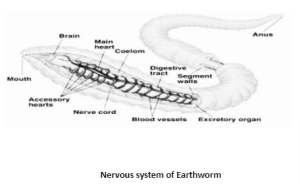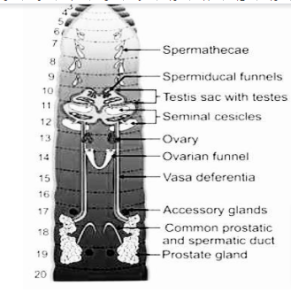Earthworms are terrestrial invertebrates belonging to the annelid phylum. They have an in-tube tube body plan, are externally segmented with corresponding internal segmentation, and usually have bristles in every segment. They are found all over the world as soil, water and temperature allow. Earthworms are commonly found in soil and eat a variety of organic matter. This organic matter includes plants, living protozoa, rotifers, nematodes, bacteria, fungi and other microorganisms. The earthworm’s digestive system runs the length of its body. It breathes through its skin. It features a dual body cavity fluid transport system that travels through a fluid-filled body cavity and a simple closed circulation system. There is a central nervous system and a peripheral nervous system. Its central nervous system consists of two ganglia above the mouth, one on each side, connected to the nerves that run along its length in each segment of motor neurons and sensory cells. Many chemoreceptors are concentrated near the mouth. The perimeter and longitudinal muscles that line each segment allow the worm to move. Similar muscle groups cover the intestines, and their action shifts food digestion to the worm’s anus.
Earthworms are hermaphroditic, each with male and female reproductive organs. When mating, the two individuals exchange sperm and fertilize each other’s eggs. Each individual has genital pores in both males and females. As invertebrates, they lack a true skeleton, but retain their structure in a fluid-filled coelomic chamber that acts as a hydrostatic skeleton (according to the author). In the classic system, the male pores were open behind the female pores, so they were in the order of Opisthopora, but the inner male segment is in front of the female. Theoretical divergence studies have classified them into suborder worms of the order Haplotaxida, which can change quickly (used as fishing lures).
Large terrestrial worms are also called megadrills (translated as “big worms”), as opposed to the semi-aquatic helminths, naididae, and enchytraeidae micro-drills (“small worms”). Megadrills feature a vasculature with prominent critellam (larger than micro drills) and true capillaries.
Scientific classification
Kingdom: Animalia
Phylum: Annelida
Class: Clitellata
Order: Opisthopora
Suborder: Lumbricina
Anatomy
They have a long cylindrical body divided into segments called metamers. The ventral surface contains the genital opening and the dorsal surface contains the mid-dorsal line. The first segment of the body called the periosteum contains the mouth, and the 1416 segments are covered by a dark band called the clitoris.
Genital foramen: A single genital foramen is present on the midline of segment 14 and a pair of male genital foramen is present at segment 18 on the ventral side.
Movement: All segments except the first, last, and critellam contain S-shaped bristles for movement
Gastrointestinal tract: A straight tube from start to finish, with an esophagus leading to the oral cavity, muscular pharynx, and gizzards. Helps crush soil particles and rot leaves. The stomach and small intestine connect to the anus.
Vascular system: The closed vasculature is composed of the heart, blood vessels, and capillaries. The fourth, fifth, and sixth segments are blood cells that dissolve in plasma and blood glands that produce hemoglobin.
Nervous system: Expressed by ganglia arranged in segments on the regular ventral nerve. Nerves present in the anterior region (3rd and 4th segments) bifurcate and merge with the dorsal ganglia to form a nerve ring.

Nervous system of Earthworm
Reproduction: Two pairs of testes are present in the 10th and 11th segments, in the 18th segment, the prostate gland and the vas deferens open to the surface like the male genital opening. A pair of ovaries is attached to the septum of segments 12 and 13. The female genital foramen opens on the ventral surface of segments 14. The exchange of sperm takes place during mating.

Reproductive system of Earthworm
Excretory system: The excretory organs are coiled segmental tubes called nephridia. There are three types of nephridia: Uterine armpit, Integral Nephridia and Kidney pharynx.
Fertilization: Mature sperm and eggs deposit with nutrients in the cocoons of the soil where fertilization occurs.
Morphology of Earthworm
Earthworms have a reddish-brown segmented tubular body. The body is precisely divided into smaller segments. There are dark blood vessel lines on the dorsal side and genital openings on the ventral side. The inner edge is distinguished by the mouth and the prostomium, an organ that helps dig a hole. In the adult earthworm segments 14-16, there is a glandular tissue called Criterlam. This helps to distinguish between the ends of the mouth and tail. The body should be divided into three segments: prepatellar bursitis, prepatellar bursitis, and prepatellar bursitis. Earthworms have the ability to carry both male and female reproductive organs. Four pairs of sperm openings are housed in segments 5-9. The 14th segment contains the female genital pores, Eid, and the 18th segment contains the male genital pair. Except for the first, last, and clitelum segments, S-shaped bristles are present and contribute to the movement of earthworms.
Conclusion
Earthworms divide a long cylindrical body into short segments of 100120. In adults, segment 1416 is covered with a prominent dark band of glandular tissue called criterium. With the exception of the first, last, and Critella segments, each segment has bristles that aid in movement. Earthworms have various pores and openings. They are for the mouth, anus, female genital pores, male genital pores, accessory gland openings, sperm openings, renal pelvis and dorsal holes.
 Profile
Profile Settings
Settings Refer your friends
Refer your friends Sign out
Sign out






